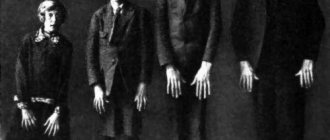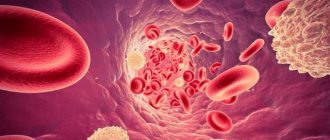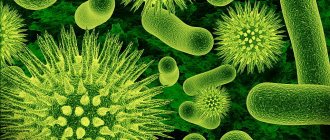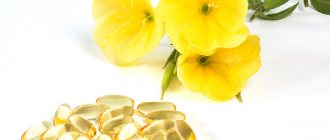Published: 07/30/2021 12:45:00 Updated: 07/30/2021
Gilbert's syndrome is the most common form of hereditary pigmentary hepatosis, characterized by impaired bilirubin metabolism due to a genetic defect in microsomal liver enzymes. Often the disease is asymptomatic for many years, but under the influence of provoking factors intermittent jaundice, dyspeptic and asthenovegetative disorders can occur.
Diagnosis requires collecting a family history, laboratory and instrumental studies. In the treatment of Gilbert's syndrome, medications of different groups are used.
Gilbert's syndrome according to the ICD corresponds to code E80.4. Men suffer from this disease four times more often than women. In general, the prevalence of pathology in European and Asian countries does not exceed 5%.
Reasons for appearance
Normally, in humans, during the breakdown of red blood cells, a substance toxic to the body is formed - indirect bilirubin.
It is neutralized by liver cells, which ensure its binding to glucuronic acid and conversion into water-soluble direct bilirubin. Subsequently, this compound is excreted through the organs of the biliary system with feces and urine. The cause of congenital Gilbert's syndrome is a genetic mutation of the microsomal enzyme UDP-glucuronyltransferase, which is responsible for the binding of glucuronic acid to indirect bilirubin. The second mechanism for the development of the disease is considered to be a violation of the uptake of bilirubin by microsomes of the vascular pole of the liver cell and its transport by glutathione-S-transferase. Thus, the concentration of toxic metabolic products in the blood serum increases. As a result, unconjugated bilirubin accumulates in tissues, turning them yellow. Inheritance of the pathology occurs according to an autosomal dominant pattern.
Predisposing factors that provoke clinical manifestations of the disease include:
- unbalanced diet, strict diet or fasting;
- loss of body fluids, dehydration;
- stress, physical fatigue;
- menstrual bleeding;
- infectious processes;
- operations;
- taking alcohol and certain medications.
General information
The main external sign of Gilbert's syndrome is the characteristic yellowing of the skin, eye sclera and mucous membranes of the oral cavity. The pathology does not cause structural changes in the liver tissue and is periodic. As a rule, metabolic defects do not manifest themselves in any way until adolescence and are discovered by chance during an examination carried out for another reason.
Congenital inherited pathology is a decrease in the production of the enzyme glucuronyltransferase in the liver tissue, which is why a certain amount of unbound bilirubin, a breakdown product of hemoglobin, remains in the blood. Exacerbation usually occurs due to:
- viral or bacterial infection that occurs with an increase in temperature;
- injury or surgery;
- in women - the onset of menstruation;
- violation of the recommended diet, eating foods that create additional stress on the liver;
- malnutrition or starvation;
- excessive insolation;
- lack of sleep;
- severe fluid loss;
- high physical or psychological stress, stress;
- taking certain medications, which include some antibiotics, hormonal drugs, caffeine, etc.;
- alcohol intoxication.
There is a congenital form of Gilbert's syndrome, which is caused by a defect in the gene of the second chromosome, and an acquired form, which develops after acute hepatitis of viral etiology.
In general, the disease proceeds without serious complications and with a favorable prognosis, although it is accompanied by a decrease in the detoxification function of the liver.
Symptoms of Gilbert's syndrome
The first manifestations of Gilbert's syndrome in children begin in adolescence, after 11-12 years, which is associated with the inhibitory effect of sex hormones on the utilization of bilirubin.
However, the onset of the disease can occur much later, up to 30 years. The disease has a wave-like course, that is, it appears only during an exacerbation; in other periods, symptoms of Gilbert's syndrome are completely absent. The following signs are most characteristic of the pathology in question:
- Intermittent jaundice. Localization and severity can vary - from a change in color of only the sclera of the eyeballs to bright yellowness of the skin and mucous membranes throughout the body. The appearance of jaundice is always sudden, occurs after exposure to provoking factors and disappears spontaneously.
- Xanthelasma of the eyelids. Single or multiple yellowish plaques that rise above the skin.
- A feeling of heaviness in the right hypochondrium, a feeling of discomfort in the abdominal cavity. These symptoms are associated with an enlarged liver and spleen, the development of cholecystitis, biliary dyskinesia, and cholelithiasis.
- Asthenovegetative disorders. Due to intoxication of the body, rapid fatigue and depression, sleep disturbances, and excessive sweating appear.
- Dyspeptic manifestations. Loss of appetite, bitter taste in the mouth, nausea, belching, bloating and excess gas, stool disorders.
About 30% of people with Gilbert's syndrome are asymptomatic. Long periods of remission complicate the diagnosis of the pathology, which is why many patients do not know about it.
Manifestations of pathology
A latent course is characteristic of approximately a third of all cases of the disease. Most often, pathology is detected between 13 and 30 years of age during an examination carried out for another reason - for example, during a medical examination of young men of military age. During exacerbations of Gilbert's syndrome, symptoms depend on the form of the pathology:
- with dyspeptic symptoms - with nausea, heartburn, flatulence, metallic taste in the mouth and pain in the right hypochondrium;
- with asthenovegetative – with weakness, headaches, increased sweating, palpitations, sleep disturbances, anxiety, muscle pain;
- with jaundice - with a bright icteric staining of the skin and sclera without changing the color of the discharge;
- with latent – with the absence of external manifestations.
Some patients experience emotional disorders - depression, irritability, unreasonable fears and panic attacks, and in some cases, an increased tendency to behave in an antisocial manner. Doctors explain these disorders by self-hypnosis associated with mental stress due to the need to visit doctors, take tests and undergo examinations.
Are you experiencing symptoms of Gilbert's syndrome?
Only a doctor can accurately diagnose the disease. Don't delay your consultation - call
Diagnosis of Gilbert's syndrome
Making a diagnosis includes an analysis of existing complaints and clinical manifestations of the disease, clarification of the presence of episodes of jaundice and pathology of the hepato-biliary system in close relatives, and the use of laboratory and instrumental research methods.
Differential diagnosis of Gilbert's syndrome is carried out with viral and chronic hepatitis, mechanical and hemolytic jaundice, Crigler-Nayyar syndrome, Dabin-Johnson syndrome and Rotor syndrome, primary shunt hyperbilirubinemia, congenital cirrhosis of the liver, bile duct atresia. The main distinguishing feature of this disorder is an increase in the fraction of unconjugated bilirubin in the blood serum, not associated with hemolysis of erythrocytes, and a hereditary burden.
The standard list of tests when examining for Gilbert's syndrome includes:
- General clinical blood test. In some cases, there is an increase in hemoglobin levels or a decrease in the number of platelets.
- Blood chemistry. The main symptom of the disease is an increase in the concentration of total bilirubin to 34.2–85.5 µmol/l due to its indirect fraction. The values of other liver blood enzymes, such as AST, ALAT, GGTP, alkaline phosphatase, are usually within normal limits. Dysproteinemia and increased total protein concentrations may be present.
- Analysis of urine. Creatinine determination is carried out.
- Determination of markers for viral hepatitis in blood serum. In Gilbert's syndrome, the presence of Ig G to HBcAg, hepatitis A and C is uncharacteristic.
- Coprogram. A stool test for stercobilin for the pathology in question has a negative result. In difficult cases, functional laboratory tests are indicated. A decrease in bilirubin level while taking phenobarbital and its increase by 1.5-2 times after fasting, a low-calorie diet or intravenous administration of nicotinic acid confirms the diagnosis.
If indicated, DNA defects are also determined using the polymerase chain reaction method.
Research in Gilbert's syndrome reveals genetic polymorphism in the DNA fragment encoding the UDPGT enzyme. Of the instrumental methods, ultrasound examination of the abdominal organs is most often performed to exclude other liver pathologies and cholelithiasis. In children, you can use a method for determining the hepatosplenic index using ultrasound data.
Additionally, duodenal intubation and thin layer chromatography are possible. Percutaneous puncture of the liver with subsequent morphological assessment of the obtained biomaterial is performed if the patient is suspected of having chronic hepatitis or cirrhosis of the liver.
Hyperbilirubinemia in newborns
The term hyperbilirubinemia refers to any increase in the level of bilirubin in the blood above normal. Taking into account the differences in indicators in newborns who were born at different times, hyperbilirubinemia in full-term newborns is considered when the OB level is more than 256 µmol/l, and in premature ones - more than 171 µmol/l. In newborns, direct and indirect bilirubin ; therefore, two types of hyperbilirubinemia : free (or unconjugated) and associated (synonymous with conjugated).
Hyperbilirubinemia code according to ICD-10 is P59. Any hyperbilirubinemia leads to the development of jaundice, but associated bilirubinemia is a pathological condition. Jaundice syndrome in children occurs under various conditions. Jaundice of the newborn period often requires emergency measures, since indirect bilirubin is a neurotoxic poison, especially in prematurity and in a state of hypoxia. Such children are at risk of central nervous system damage (bilirubin encephalopathy).
There are various types of jaundice in newborns, which are caused by physiological pathological reasons.
Physiological hyperbilirubinemia is a moderate transient (transient) increase in unconjugated bilirubin that occurs in the neonatal period. Hyperbilirubinemia can occur in every newborn, but 50-70% manifest as jaundice (more common in premature and immature newborns).
Physiological jaundice is characterized by:
- Appears after 36 hours of a newborn’s life.
- The peak increase in total bilirubin in a full-term baby occurs on the 3-4th day and on the 5-6th day in a premature baby.
- The child's condition does not suffer: he is active, has a good sucking reflex, normal temperature, there are periods of sleep and wakefulness, the liver and spleen are not enlarged, urine and feces are normally colored.
- A decrease in indicators by the 14th day in a full-term baby and by the 21st day in a premature baby.
Physiological jaundice has no cure, but children should receive exclusive breastfeeding, which helps to overcome jaundice faster. The child should suck often and for as long as he wants, at any time of the day and at least 8-12 times. In the vast majority of cases, jaundice in newborns is physiological, but pathological jaundice must not be missed.
Pathological jaundice has the following features:
- Appears during the first day or is detected on the feet and palms immediately after birth.
- Possible appearance on the 7th day.
- The rate of increase in OB is 85 µmol/l/day.
- The condition of the newborn is unsatisfactory, pathological symptoms are present.
- Enlarged liver and spleen.
- Discolored stool (or dark urine).
- Prolonged jaundice without a tendency to decrease - after the 14th day of life and the 21st day, respectively, in full-term and premature infants.
Pathological hyperbilirubinemia can be caused by various conditions and diseases, including:
- Caused by increased production of bilirubin (these are so-called hemolytic jaundices) in hemolytic disease of the newborn, drug hemolysis , polycythaemic syndrome , ingestion of maternal blood, hemoglobinopathies .
- Arose against the background of polycythemia .
- Developed during infectious diseases.
- Conjugation: hereditary functional bilirubinemia (Gilbert, Arias, Crigler-Nayjar syndromes), metabolic disorders, impaired bilirubin conjugation in intestinal obstruction and pyloric stenosis .
- Caused by drugs or toxins.
- Caused by immaturity of the liver (for example, late onset of conjugation, when the AB count of the indirect fraction increases).
- Mechanical jaundice due to abnormal development of the biliary tract, bile thickening syndrome, familial cholestasis , cystic fibrosis , compression of the biliary tract by various formations.
Among congenital functional bilirubinemias, Gilbert's syndrome ranks first. In newborns, this disease is similar to transient jaundice. The child has hyperbilirubinemia for a long time, but there are no other pathological changes, and there are no cases of kernicterus.
Diagnosis is made based on family history. Prescribing phenobarbital gives good results. The prognosis is favorable. Apparently healthy parents in whom the syndrome is latent may give birth to a child with this syndrome. In this regard, if there have been cases of the disease in the family, the parents need to undergo a genetic examination.
In terms of time of manifestation and severity, the first place is occupied by Crigler-Nayjar syndrome type I. This is congenital familial non-hemolytic jaundice associated with the complete absence of the enzyme glucoronyltransferase , necessary for the conjugation of bilirubin. With this syndrome, liver function is normal, there is no hemolysis and Rh conflict. This syndrome manifests itself in the first days of life with a significant increase in unconjugated bilirubin (up to 400-450 mg/l) and severe kernicterus: muscle hypertonicity , nystagmus , suppression/absence of the sucking reflex, hypotension , convulsions , lethargy .
Clinically, jaundice is noted. Unconjugated bilirubin can reach a concentration of fecal urobilinogen of no more than 100 mg/l. The use of phenobarbital has no effect. The prognosis is very poor, children rarely live beyond 1.5 years.
Crigler-Nayjar syndrome type II proceeds favorably, since the activity of the enzyme glucoronyltransferase is only reduced and liver function is not impaired. The level of unconjugated bilirubin ranges from 60-250 mg/l, especially high in the first months of life, and bilirubin encephalopathy can be observed. There was a positive response to treatment with phenobarbital.
Hemolytic disease of newborns develops when the blood of mother and child is incompatible according to the Rh factor or blood groups. The disease can occur in icteric, edematous and anemic forms. Edema is the most severe and often children are not viable. The icteric form is more favorable, but can also threaten the health of the newborn. In mild cases (indirect bilirubin level less than 60 µmol/l), conservative treatment is carried out. For moderate to severe hemolytic disease, a replacement blood transfusion may be required, and photo and infusion therapy is used before the procedure.
Jaundice in hemolytic disease is either congenital or appears on the first day of life. It has a pale yellow tint, constantly progresses and symptoms of bilirubin intoxication (CNS damage) appear. The liver and spleen are enlarged, the color of feces and urine does not change. Damage to the central nervous system develops when the level of indirect bilirubin is more than 342 µmol/l; for premature and extremely preterm infants this figure is almost 2 times lower. The depth of damage to the central nervous system also depends on the time of exposure of bilirubin to brain tissue.
To prevent hemolytic disease of newborns, women with Rh-negative blood and with group 0(I) are carefully observed, their level of Rh antibodies is determined, and, if necessary, they are delivered early. All women with Rh negative blood are given anti-D globulin . In cases of obstructive jaundice in newborns, various surgical operations are performed to remove obstacles to the outflow of bile.
Treatment of Gilbert's syndrome
The mere presence of Gilbert's syndrome in children and adults is not an indication for drug treatment.
To prevent exacerbation of the disease and the development of complications, general measures are important: limiting participation in strenuous sports, prolonged exposure to the sun, consumption of alcoholic beverages and hepatotoxic drugs. Such patients need to eat right, avoid prolonged fasting, as well as foods containing indigestible fats - fatty meats, fried and spicy foods, canned foods. During an exacerbation of the clinical manifestations of the disease, plenty of fluids and a gentle diet corresponding to table No. 5 are prescribed. Conservative therapy during this period is aimed at reducing the formation and accelerating the removal from the body of excess amounts of unconjugated hemoglobin and includes:
- taking microsomal enzyme inducers (phenobarbital, zixorine);
- taking activated carbon;
- phototherapy.
For the prevention of cholecystitis and cholelithiasis in Gilbert's syndrome, the use of choleretic herbs, hepatoprotectors (ursosan, ursofalk), essential phospholipids, choleretics (cholagol, allochol, holosas) and B vitamins is recommended.
Diet
Diet 5th table
- Efficacy: therapeutic effect after 14 days
- Duration: from 3 months or more
- Cost of products: 1200 - 1350 rubles per week
It has already been said above that the diet of patients should be regular (long breaks between meals and fasting are prohibited), moderate (do not overeat) and dietary. Patients are prescribed Diet No. 5 , excluding fatty and spicy foods, fried foods, cooking fats, canned food, smoked foods, products with cream, coffee, cocoa, and chocolate.
Prognosis and prevention
The prognosis of the disease at any age is favorable.
Hyperbilirubinemia in Gilbert's syndrome persists for life, but is benign in nature, is not accompanied by progressive changes in the liver and does not affect life expectancy. Source of statistical data: Visual pediatric gastroenterology and hepatology: textbook. allowance — Kildiyarova R. R., Lobanov Yu. F. 2013. — 124 p. : ill. (Chapter 6. Liver diseases (vmede.org).
Author:
Pugonina Tatyana Alekseevna, Therapist
List of sources
- Diseases of the fetus and newborn, congenital metabolic disorders / ed. R. E. Berman, V. K. Vaughan. M.: Medicine, 1991. 527 p.
- Podymova S. D. Liver diseases. M.: Medicine, 1993. - 544 p.
- Kolyubaeva S.N., Kulagina K.O., Petrova I.S., Krivoruchka A.B., Ivanova A.M. Molecular genetic diagnosis of Gilbert's syndrome using pyrosequencing. Laboratory of health care facilities. 2016; 8:4–6.
- Goncharik I.I. Gilbert's syndrome: pathogenesis and diagnosis / I.I. Goncharik, Yu.S. Kravchenko // Clinical medicine. - 2001. - No. 4. - P. 40-44.
- Kuznetsov A.S., Fomina I.G., Tarzimanova A.I., Oganesyan K.A. Differential diagnosis of benign hyperbilirubinemia // Clinical medicine. - 2001. - No. 3. - P. 8-13.
Classification
In the case of this pathology, the doctor does not experience difficulties with classification. Gilbert's syndrome has a single form of the disease and therefore it is not accepted to officially classify it. But for convenience, the diagnosis can reflect its most striking symptom or absence of symptoms, thus indicating the clinical variant of the course. In accordance with this, we can distinguish variants of the disease:
- Dyspeptic.
- Asthenovegetative.
- Icteric.
- Latent.
The time when symptoms appear is called the period of exacerbation of the disease, and when there are no symptoms, they speak of remission or latent period.







